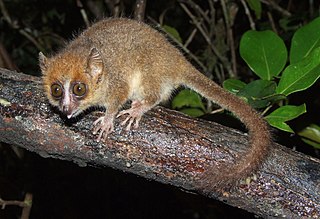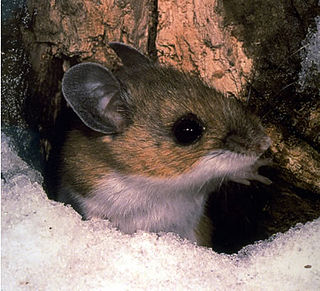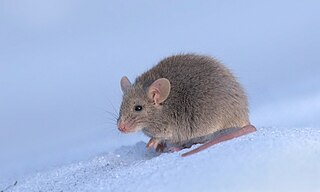
The blue whale is a marine mammal and a baleen whale. Reaching a maximum confirmed length of 29.9 m (98 ft) and weighing up to 199 t, it is the largest animal known ever to have existed. The blue whale's long and slender body can be of various shades of greyish-blue on its upper surface and somewhat lighter underneath. Four subspecies are recognized: B. m. musculus in the North Atlantic and North Pacific, B. m. intermedia in the Southern Ocean, B. m. brevicauda in the Indian Ocean and South Pacific Ocean, and B. m. indica in the Northern Indian Ocean. There is a population in the waters off Chile that may constitute a fifth subspecies.

Balaenoptera is a genus of rorquals containing eight extant species. Balaenoptera comprises all but two of the extant species in its family ; the genus is currently polyphyletic, with the two aforementioned species being phylogenetically nested within it.

Peromyscus is a genus of rodents. They are commonly referred to as deer mice or deermice, not to be confused with the chevrotain or "mouse deer". They are New World mice only distantly related to the common house and laboratory mouse, Mus musculus. From this relative, Peromyscus species are distinguished by relatively larger eyes, and also often two-tone coloring, with darker colors over the dorsum (back), and white abdominal and limb hair-coloring. In reference to the coloring, the word Peromyscus comes from Greek words meaning "booted mouse". They are also accomplished jumpers and runners by comparison to house mice, and their common name of "deer mouse" is in reference to this agility.

The pygmy mouse lemur, also known as Peters' mouse lemur or dormouse lemur, is a primate weighing only 43–55 g (1.5–1.9 oz); it is the second smallest of the mouse lemurs. Its dorsal side is a rufous-brown colour, and creamy-white ventrally. It lives in dry deciduous forests of western Madagascar. It has been captured in the Tsingy de Bemaraha Nature Reserve, the Andramasy forests north of Belo sur Tsiribihina, and the border of heavily degraded deciduous forest and savanna at Aboalimena. It has also been found in other habitats, in mangroves in two localities.

The Neotominae are a subfamily of the family Cricetidae. They consist of four tribes, 16 genera, and many species of New World rats and mice, predominantly found in North America. Among them are the well-known deer mice, white-footed mice, packrats, and grasshopper mice.

Apodemus is a genus of Muridae. The name is unrelated to that of the Mus genus, instead being derived from the Greek ἀπό-δημος.

The genus Mus or typical mice refers to a specific genus of muroid rodents, all typically called mice, though the term can be used for other rodents. They are the only members of the tribe Murini. However, the term mouse can also be applied to species outside of this genus.
The pygmy blue whale is a subspecies of the blue whale found in the Indian Ocean and the Southern Pacific Ocean.

The least forest mouse is a species of rodent in the family Muridae. It is found only in the Philippines.

The southern pygmy mouse is a species of rodent in the family Cricetidae. It is found in El Salvador, Guatemala, Honduras, Mexico, and Nicaragua.

The northern pygmy mouse is a species of rodent in the family Cricetidae. It is known as ratón-pigmeo norteño in the Spanish-speaking areas of its range. It is found in Mexico and the United States.
Oligoryzomys magellanicus, also known as the Patagonian colilargo and the Magellanic pygmy rice rat, is a species of rodent in the genus Oligoryzomys of the family Cricetidae. It is found in the southernmost parts of Argentina and Chile, including Tierra del Fuego and other outlying islands. Its karyotype has 2n = 54 and FNa = 66.
Petromyscus is a genus of rodent in the family Nesomyidae. It is so distinct from other rodents that it is placed as the only genus in subfamily Petromyscinae. In previous classifications, Delanymys brooksi has also been placed in the subfamily. They are found in southwestern Africa. These animals have a sharp lower point to their V-shaped infraorbital canal. Their molars are intermediate between the ancestral cricetid style tooth and the dendromurine style tooth.

Scotinomys is a genus of rodent, the singing mice, in the family Cricetidae. Together with Baiomys, it forms the tribe Baiomyini. It contains the following species:
Pygmy mouse may refer to:
The binomial abbreviation B. musculus may refer to:











